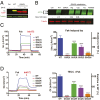Ataluren stimulates ribosomal selection of near-cognate tRNAs to promote nonsense suppression
- PMID: 27702906
- PMCID: PMC5098639
- DOI: 10.1073/pnas.1605336113
Ataluren stimulates ribosomal selection of near-cognate tRNAs to promote nonsense suppression
Abstract
A premature termination codon (PTC) in the ORF of an mRNA generally leads to production of a truncated polypeptide, accelerated degradation of the mRNA, and depression of overall mRNA expression. Accordingly, nonsense mutations cause some of the most severe forms of inherited disorders. The small-molecule drug ataluren promotes therapeutic nonsense suppression and has been thought to mediate the insertion of near-cognate tRNAs at PTCs. However, direct evidence for this activity has been lacking. Here, we expressed multiple nonsense mutation reporters in human cells and yeast and identified the amino acids inserted when a PTC occupies the ribosomal A site in control, ataluren-treated, and aminoglycoside-treated cells. We find that ataluren's likely target is the ribosome and that it produces full-length protein by promoting insertion of near-cognate tRNAs at the site of the nonsense codon without apparent effects on transcription, mRNA processing, mRNA stability, or protein stability. The resulting readthrough proteins retain function and contain amino acid replacements similar to those derived from endogenous readthrough, namely Gln, Lys, or Tyr at UAA or UAG PTCs and Trp, Arg, or Cys at UGA PTCs. These insertion biases arise primarily from mRNA:tRNA mispairing at codon positions 1 and 3 and reflect, in part, the preferred use of certain nonstandard base pairs, e.g., U-G. Ataluren's retention of similar specificity of near-cognate tRNA insertion as occurs endogenously has important implications for its general use in therapeutic nonsense suppression.
Keywords: Translarna; base mispairing; nonsense suppression; readthrough.
Conflict of interest statement
B.R., W.J.F., Y.T., J.Z., B.J., J.D., C.R.T., X.X., and E.M.W. are employees of PTC Therapeutics Inc. (PTCT). A.J. is a cofounder, director, and consultant for PTCT, and D.M.B. is a consultant for PTCT. S.M.R. receives grant support from PTCT to conduct clinical trials for the treatment of cystic fibrosis.
Figures




Comment in
-
Proposing a mechanism of action for ataluren.Proc Natl Acad Sci U S A. 2016 Nov 1;113(44):12353-12355. doi: 10.1073/pnas.1615548113. Epub 2016 Oct 19. Proc Natl Acad Sci U S A. 2016. PMID: 27791186 Free PMC article. No abstract available.
References
-
- Welch EM, et al. PTC124 targets genetic disorders caused by nonsense mutations. Nature. 2007;447(7140):87–91. - PubMed
-
- Li M, Andersson-Lendahl M, Sejersen T, Arner A. Muscle dysfunction and structural defects of dystrophin-null sapje mutant zebrafish larvae are rescued by ataluren treatment. FASEB J. 2014;28(4):1593–1599. - PubMed
Publication types
MeSH terms
Substances
Grants and funding
LinkOut - more resources
Full Text Sources
Other Literature Sources

